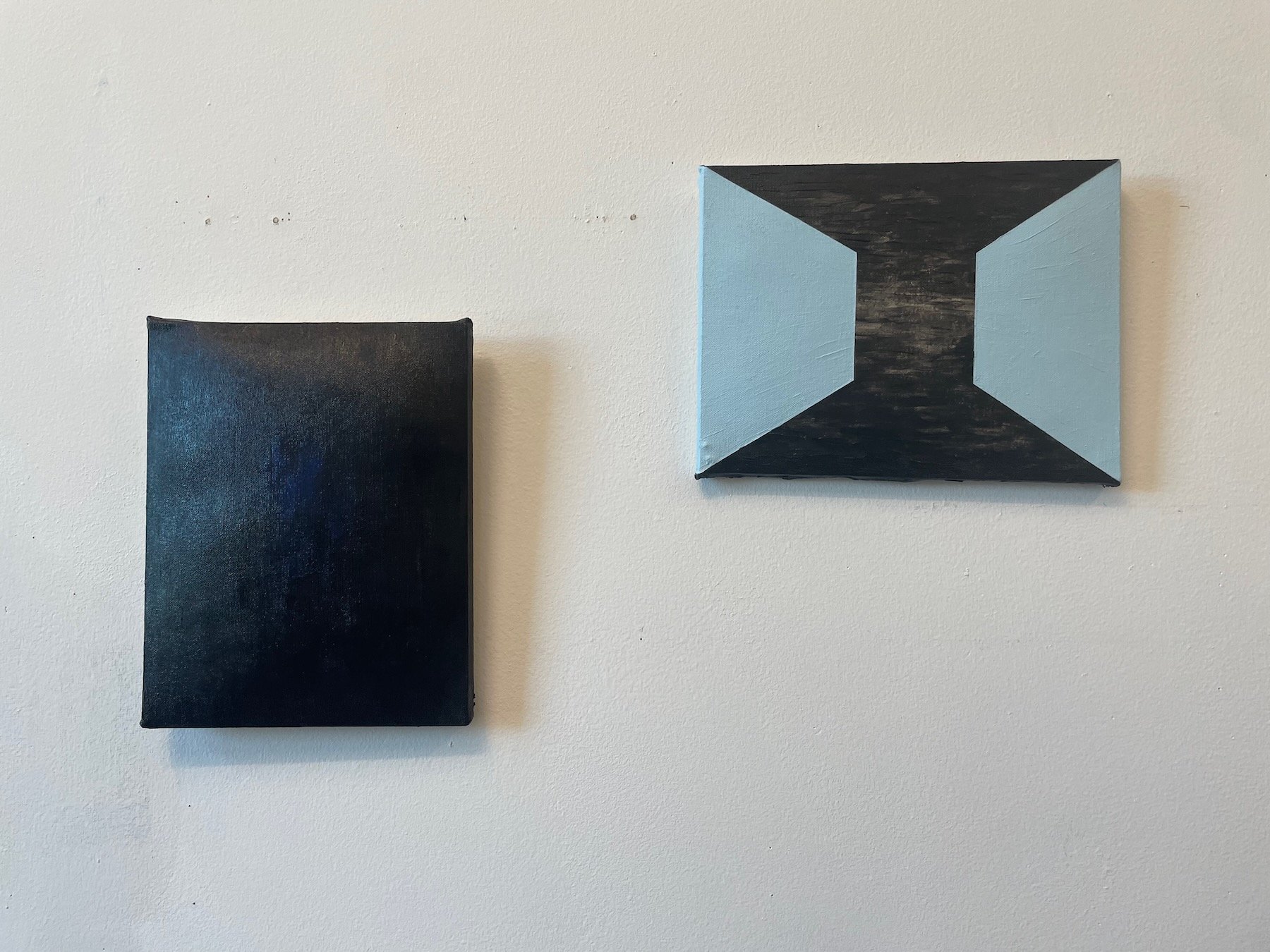The fall was spent with wood fabrication and getting settled in my new studio space (see previous post). In the spring, I followed through with some of the experiments I had begun in the later part of the fall semester. I also took my first two college credit art history courses: Contemporary Art Criticism (Raphael Rubinstein) and Drawing in the Expanded Field (Natilee Harren).
The latter class was particularly enlightening as it was a deep dive into the medium of drawing with an emphasis on the conceptual drawing practices that began in the 1960s and 70s. My previous experience with art history had been limited to rabbit holes, museum visits, and a couple of courses at the Glassell School of Art taught by Anna Tahinci–I highly recommend her classes if you are at all curious and looking for somewhere to start.
Series of unstretched map works. Acrylic on canvas.
Studio Work
Place and mapmaking continue to be a theme in my practice. I started a larger unstretched canvas piece that very directly references mapping at the beginning of the year, yet I haven’t touched it for a couple of months. This new work, along the with the three previous works that sit alongside it, is a point of fermentation as I consider where I want to take the original ideas (urban life in the context of the digital era, urban planning, dislocation, and Houston) that initiated it.
I momentarily stepped away from red and blue (a color palette I prefer since working on Form the Cave) and explored green.
In February and March, I experimented with a few different painting approaches on canvas before settling on the pursuit of more object-based work. The paintings/objects reference the screen, the body, impermanence and the digital, and painting (as illusion depicted on stretched canvas).
Series of stuffed acrylic canvases. 8 ¼ x 11 ¼ x ½ inches.
Suspended acrylic on canvas in artist-built birch frame.
Some artists I have been looking at include Eva Hesse, Tracy Grayson, Sean Scully, Laura Owens, RH Quaytman, and Francis Alÿs. That is in addition to the artists like Gego, Ruth Asawa, and Dorothea Rockburne, all of whom I have gotten to study thanks to Harren’s class.
Nancy Spero
In the latter part of the semester, I spent a great deal of time studying Nancy Spero as her work was the subject of my research for Harren’s class. Visiting the Menil Drawing Institute with my classmates throughout the semester, we selected work on paper to contribute research to. Mine was Bomb (1966)–an early work from The War Series, a haunting collection of works on paper made in response to the Vietnam War.
Nancy Spero
Bomb, 1966, Gouache and ink on paper, 27 ¼ × 33 15/16 in.
The Menil Collection
© The Nancy Spero and Leon Golub Foundation for the Arts / VAGA at Artists Rights Society (ARS), NY
Angry at both the war and at the art world in general, The War Series is emotive, urgent, and abrupt. Spero’s aggressive brushwork, paired with the fragile paper, created work that embodied violence. To yield a heightened, visceral response, she also made her work explicitly sexual: “I wanted to be as shocking as possible, and the way that could be most shocking, because it so upset people, was through sexuality. It was two things: trying to shock, a shock of recognition, and knowing the relationship between sex and power.”
Nancy Spero
Female Bomb, 1966, Gouache and ink on paper, 34 x 27 inches.
University Art Collection, New School University.
Reproduced from Spero, Storr, Leon Golub, Nancy Spero: The War Series 1966-1970.
While Spero’s feminist activism may lead some viewers to assume that she limited her scope to male sexuality in the context of power, that was not the case. She also found women complicit and used female sexuality when referencing aggression: “The bomb, the symbol of destruction, is mostly male and phallic, but both female and male organs appear on some of the bodies. I had a penis on one side and breasts on the other spewing out poison, and that had to do with power and sex: it wasn’t just gender. It did have the implications of sex and power, of phallic power, knowing that power in itself transcends gender.”
I could go on and include more quotes and discussion of the specific work, but I will stop there for now.
Reading
Besides art books, I have had the pleasure of reading Donna Haraway with Basket Books’ “Theory Social”, short stories by Katherine Anne Porter, and several works by J.G. Ballard (Concrete Island, The Drowned World, and The Wind from Nowhere).
I have forgotten what/who pointed me to Porter, but I chose Ballard based on multiple artists referencing his intriguing sense of landscape and time. Ballard’s stories and Robert Smithson’s study of entropy are particularly well aligned. The Drowned World while placed atop a post-apocalyptic London felt like a vivid portrayal of Houston in the not-so-far future. If I read it during Hurricane Harvey, I would have really felt submerged in the setting. Most interesting about this novel was the protagonist’s mind and memory slowly melding with the landscape which had begun to recede back in time to the Triassic period:
“That wasn’t a true dream, but an ancient organic memory millions of years old. The innate releasing mechanisms laid down in your cytoplasm have been awakened. The expanding sun and rising temperatures are driving you back down to the spinal levels into the drowned seas of the lowest layers of your unconscious, into the entirely new zone of the neuronic psyche. This is the lumbar transfer, total psychic recall. We really remember these swamps and lagoons.”
Next
Over the summer, I will study with Abinadi Meza in Marfa (via UH School of Art) and then return to my studio to continue working on maps and screens and relaunch my drawing practice in earnest.





